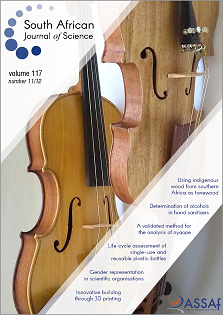Antibiotic resistance profiles of Staphylococcus spp. from white button mushrooms and handlers
DOI:
https://doi.org/10.17159/sajs.2021/8667Keywords:
staphylococci, antibiotic genes, antibiotic resistanceAbstract
The presence of Staphylococcus spp. has increasingly been reported in food products and poses a public health threat. The aim of this study was to determine the diversity of Staphylococcus spp. and the antibiotic resistance profiles of isolates obtained from freshly harvested and packed ready-to-eat mushrooms (n=432) and handlers’ hands (n=150). A total of 56 Staphylococcus isolates [46.4% (n=26) from hands and 53.6% (n=30) from mushrooms] were recovered belonging to 10 species. Staphylococcus succinus isolates (n=21) were the most prevalent, of which 52.4% came from mushrooms and 47.6% from hands. This was followed by S. equorum isolates [n=12; 91.7% (n=11) from mushrooms and 8.3% (n=1) from hands] and S. saprophyticus [n=9; 66.7% (n=6) from mushrooms and 33.3% (n=3) from hands]. Six isolates that were characterised as multidrug resistant were isolated from hands of handlers. Most (83.9%; n=47) of the 56 isolates were resistant to penicillin [53.2% (n=25) from mushrooms and 46.8% (n=22) from hands] and 14.3% (n=8) were resistant to cephalosporin classes [25% (n=2) from mushrooms and 75% (n=6) from hands], both of which are used to treat staphylococcal infections. Antibiotic resistance genes blaZ [25.0% (n=14) of all isolates of which 71.4% (n=10) were from hands and 28.57% (n=4) from mushrooms], tetL and tetK [both 1.8% (n=1) from hands], mecA [5.4% (n=3) from hands] and ermA [1.8% (n=1) from mushrooms] were detected from the 56 isolates. Only two (25.0%) of the eight methicillin-resistant staphylococci harboured the mecA gene, while only 11 (23%) of the 47 penicillin-resistant isolates harboured the blaZ gene [36.4% (n=4) from mushrooms and 63.6% (n=7) from hands]. Our results demonstrate that food handlers and harvested and packed ready-to-eat mushrooms could be a source of diverse Staphylococcus spp. that exhibit antimicrobial resistance. Clinically relevant S. aureus was only detected on one handler’s hand; however, the isolate was not multidrug resistant. The presence of diverse Staphylococcus spp. on mushrooms and the hands of handlers is a potential public health concern due to their potential to cause opportunistic infections.
Significance:
- This study is the first to describe the antibiotic resistance profiles and antibiotic gene presence of Staphylococcus spp. isolated from fresh mushrooms and hands of pickers and packers. Mushrooms and handlers in this study were demonstrated to be possible routes of transmission of Staphylococcus spp. that are antibiotic resistant and which harbour antibiotic resistance genes, presenting a possible public health hazard.
Published
Issue
Section
License

All articles are published under a Creative Commons Attribution 4.0 International Licence
Copyright is retained by the authors. Readers are welcome to reproduce, share and adapt the content without permission provided the source is attributed.
Disclaimer: The publisher and editors accept no responsibility for statements made by the authors
How to Cite
- Abstract 773
- PDF 732
- EPUB 242
- XML 265
Funding data
-
National Research Foundation
Grant numbers UID 74426 -
Department of Science and Innovation, South Africa
-
University of Pretoria













.png)